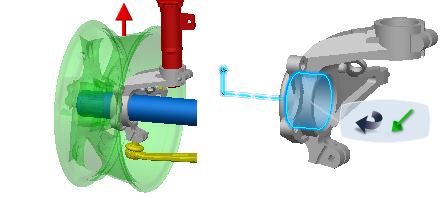About Forces | ||||
|
| |||
Click Play to watch the video:
A force definition consists of four components:
- the application point (defined by the location of the robot);
- the direction (defined by the orientation of the robot);
- the transmission surface (defined by the selected model face); and
- a specified magnitude.
The force is transmitted from the application point across the transmission surface. When you select a face on your model, the robot snaps to a default location close to the center of that face. Applying the concentrated force at the center of the transmission surface distributes the force evenly across the surface. If you move the application point so it is not at the center of the transmission surface, the entire surface deflects accordingly. If you move the application point so it is not even touching the transmission surface, the force is transmitted as if invisible beams were connecting the application point to the transmission surface.

This treatment of forces is a very good approximation of how actual structures behave. For simple weights or direct loads, you can select several faces and apply the force at the default center location. Alternatively, the selected face may represent a connection with another part in your assembly, and the applied force occurs via contact at the transmission surface. Offsetting a force is an easy but effective way to represent a force that originates far from your part but is transmitted to your part via other assembly components.
For example, if the wheel in the assembly below travels over a bump, it experiences a vertical force that gets transmitted to the central component—called a steering knuckle—through the axle. To represent this force on the knuckle, select the knuckle faces that contact the axle and position the force at the location of the wheel.
